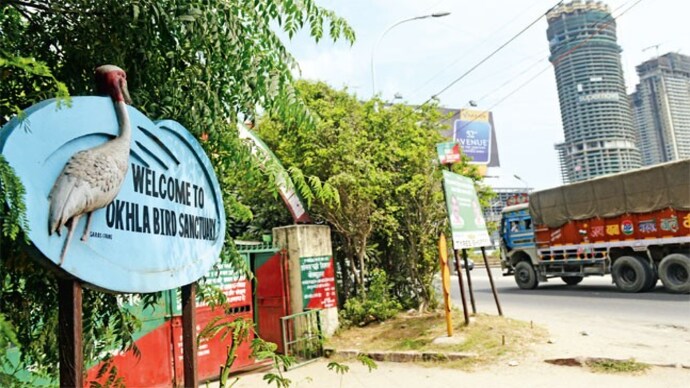Visiting Okhla bird sanctuary anytime soon? Brace yourself for a heartbreak
Experts blame the buzz emanating from high-tension electric lines, poor maintenance of floating water plants, heavy sewage inflow at Kalindi Kunj among other reasons for the deterioration of the sanctuary.

How does one kill an old and protected natural habitat?
The Okhla bird sanctuary on the Delhi-Noida border seems to be a textbook example for this frightful objective. Once a prized haven for resident and migratory birds - including gulls, geese, ducks and flamingoes that came from as far as Europe and Russia in thousands - the sanctuary has hardly witnessed any chirping of late.
Experts blame the buzz emanating from high-tension electric lines, poor maintenance of floating water plants, heavy sewage inflow at Kalindi Kunj, excessive construction and traffic on all sides, the chopping away over 10,000 trees for BSP leader Mayawati's Prerna Sthal , and 24x7 light and noise pollution for the prevailing situation. And if these were not enough, the site is going to be drained of all water this season .
"It is unfortunate," said Ishwar Chandra Singh, forest ranger with additional charge of the Okhla sanctuary, "The UP Irrigation Department is going to change 18 of the 27 gates in the barrage which are in a rusting and collapsible situation." Singh said while the replacement of gates was necessary, it should have taken place at a period not coinciding with the migratory period.
But the tardy process of government clearance will ensure no winged visitors this year. "The irrigation department had applied, in fact, much earlier for the work to be completed between April and June, when it would not have coincided with the birds' season, but they received the permission only now. The birds are most likely to fly away to nearby Delhi Zoo, Surajpur wetland, Yamuna Biodiversity Park, but not come here at least till next winter now," Singh said. Nature lovers describe the draining of water as merely the last nail.
"The sanctuary exists only in name now," said well-known birder KB Singh. "First, it was the Dalit Prerna Sthal which took away so many trees that provided nesting spots to terrestrial birds. Then came the high-tension wires which make a constant humming sound and distract the birds. Now, there is the continuously flowing traffic and a number of townships coming up on Sarita Vihar side . Birds are peace and quiet-loving species, how do you expect them to roost here?" The other issue pertains to the maintenance of the sanctuary.
"It is baffling that the sanctuary management doesn't care to clean up the floating plants, water hyacinth, and typha reed grass despite influx of huge funds from the government," Vikrant Tongad, an RTI activist and nature lover, told Mail Today.
"As per an RTI reply received by us, a total of Rs 1.22 crore have been allocated by the UP government just for this task in last three years. It is essential for these plants to be cleared. For, birds flying overhead will be able to see the water and creatures beneath, which are food for them, only when this foliage is removed."
Anand Arya, who has been visiting the Okhla sanctuary for decades now, told Mail Today, "There are housing societies coming up right up to the water's edge. Plus, birds which come from the west and north direction use the Yamuna as a guiding map. In a lot of these stretches of the river, agriculture or mining is going on now. This had harmed the migratory influx." "Even 5-10 years back, we used to spot up to 100 species of birds. I have seen flocks of 500-600 flamingoes at a time here, but they hardly come here now. There's nothing to see and I doubt a revival is on the cards," he added.
The sanctuary was declared protected by the UP government in 1990 after the formation of a large wetland due to creation of the Okhla barrage where the Yamuna leaves Delhi and enters Noida. It is one of the state's 15 wildlife sanctuaries. Several rare species of birds like ferruginous pochard, black-bellied tern, grey-headed fish eagle, Baikal teal, Baer's pochard and sarus crane, among others have been seen here before.
